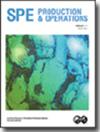蒸汽辅助重力排水生产井钢丝网筛性能与孔径选择的实验关联
IF 1.3
4区 工程技术
Q2 ENGINEERING, PETROLEUM
引用次数: 8
摘要
金属丝网(WWSs)是蒸汽辅助重力排水(SAGD)操作员最常用的设备之一,因为它具有控制堵塞和提高流动性能的能力。污水处理系统提供高的开放流动面积(OFA)(6%至18%),允许细粒的高释放,因此,在近筛网区域的孔隙堵塞和积聚较少。多年来,根据不同的工业环境和实验室实验,已经提出了几种选择孔径大小的标准。通常,现有的孔径大小建议仅包括颗粒大小分布(PSD)的一个点。操作员和学者依靠防砂测试来评估防砂装置(SCD)的性能。规模化实验室测试提供了一个简单的工具,可以了解流速、流动相、流体特性、应力和筛网规格对固沙和流动损伤的作用。本研究采用了大规模的预填固沙试验(SRT)来实验评估污水处理系统在可变单相和多相条件下的性能。实验结果和参数趋势用于建立一组描述WWS响应的经验方程。测试了几种具有不同细粒含量和粒度的PSD类别,以评估广泛的PSD。操作程序包括同时注入天然气、盐水和石油,以模拟蒸汽突破事件期间的侵蚀性条件。实验研究得出了预测相关性的公式。准备了额外的PSD,以验证所提出的方程的充分性。结果表明,出砂方式与流量和流动相都有相关性。此外,出砂的严重程度或强度在很大程度上受粒度与孔径之比和形成稳定桥梁的能力的影响。在气体和多相流过程中,由于高多相流速度造成的较宽孔径,观察到大量的砂光。然而,液相阶段表现出不那么强烈的瞬态行为。值得注意的是,即使对于低质量的沙子和狭窄的孔隙,污水处理系统也能提供出色的流动性能。尽管还需要进一步和更完整的测试,但经验相关性与实验结果显示出良好的一致性。本文章由计算机程序翻译,如有差异,请以英文原文为准。
Experimental Correlations for the Performance and Aperture Selection of Wire-Wrapped Screens in Steam-Assisted Gravity Drainage Production Wells
Wire-wrapped screens (WWSs) are one of the most-commonly used devices by steam-assisted gravity drainage (SAGD) operators because of the capacity to control plugging and improve flow performance. WWSs offer high open-to-flow area (OFA) (6 to 18%) that allow a high release of fines, hence, less pore plugging and accumulation at the near-screen zone. Over the years, several criteria have been proposed for the selection of aperture sizes on the basis of different industrial contexts and laboratory experiments. Generally, existing aperture-sizing recommendations include only a single point of the particle-size distribution (PSD). Operators and academics rely on sand-control testing to evaluate the performance of sand-control devices (SCDs). Scaled laboratory testing provides a straightforward tool to understand the role of flow rate, flowing phases, fluid properties, stresses, and screen specifications on sand retention and flow impairment.
This study employs large-scale prepacked sand-retention tests (SRTs) to experimentally assess the performance of WWSs under variable single-phase and multiphase conditions. The experimental results and parametric trends are used to formulate a set of empirical equations that describe the response of the WWS. Several PSD classes with various fines content and particle size are tested to evaluate a broad range of PSDs. Operational procedures include the coinjection of gas, brine, and oil to emulate aggressive conditions during steam-breakthrough events.
The experimental investigation leads to the formulation of predictive correlations. Additional PSDs were prepared to verify the adequacy of the proposed equations. The results show that sanding modes are both flow-rate and flowing-phase dependent. Moreover, the severity or intensity of producing sand is greatly influenced by the ratio of grain size to aperture size and the ability to form stable bridges. During gas and multiphase flow, a dramatic amount of sanding was observed for wider apertures caused by high multiphase flow velocities. However, liquid stages displayed less-intense transient behaviors. Remarkably, WWSs rendered an excellent flow performance even for low-quality sands and narrow apertures. Although further and more complete testing is required, empirical correlations showed good agreement with experimental results.
求助全文
通过发布文献求助,成功后即可免费获取论文全文。
去求助
来源期刊

Spe Production & Operations
工程技术-工程:石油
CiteScore
3.70
自引率
8.30%
发文量
54
审稿时长
3 months
期刊介绍:
SPE Production & Operations includes papers on production operations, artificial lift, downhole equipment, formation damage control, multiphase flow, workovers, stimulation, facility design and operations, water treatment, project management, construction methods and equipment, and related PFC systems and emerging technologies.
 求助内容:
求助内容: 应助结果提醒方式:
应助结果提醒方式:


